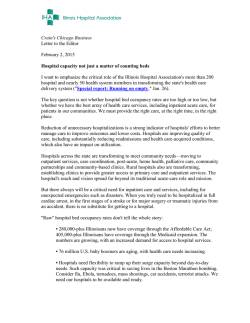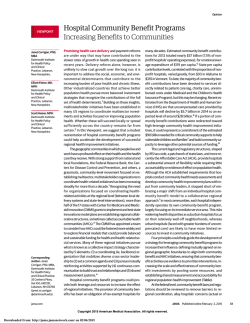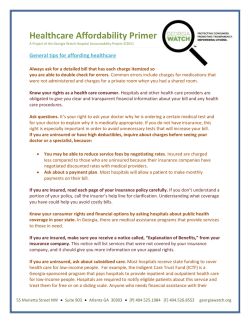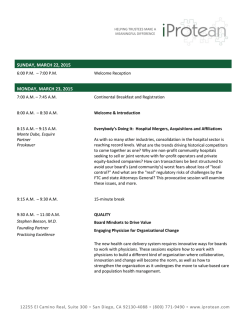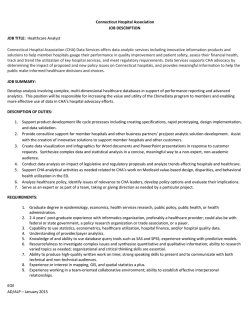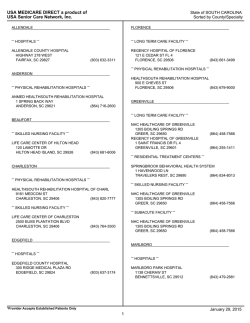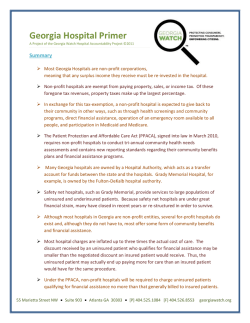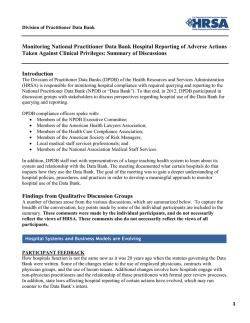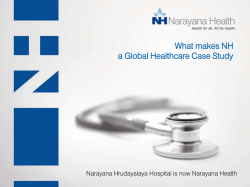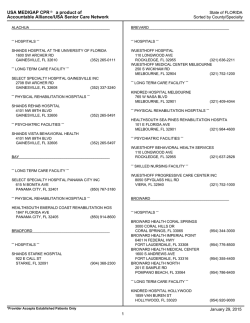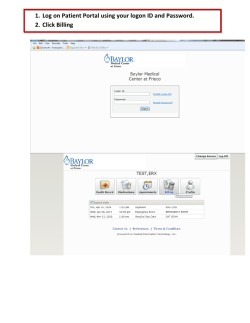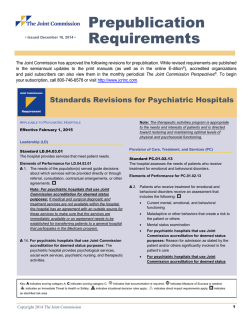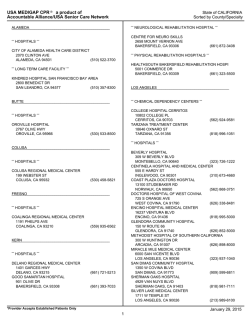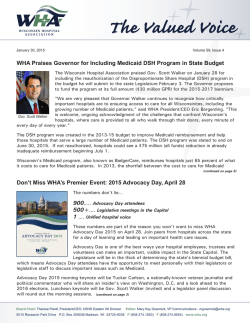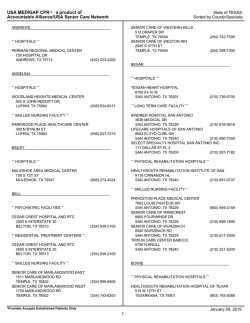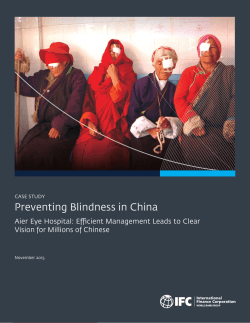
Hospital Accountability Project
Hospitals and the Patient Protection and Affordable Care Act On March 23, 2010, the President signed into law the Patient Protection and Affordable Care Act, an expansive health law that puts into place certain regulations on the insurance industry and expands health coverage for millions of Americans. Through Section 9007, the law also addresses the practices of private nonprofit hospitals, implementing crucial consumer protections in regards to billing, collections and alerting patients that financial assistance is available. In addition, the law requires hospitals to assess and address the needs of its community. This policy brief addresses those particular provisions. Patient billing protections Limit on charges and collections: All nonprofit hospitals must now limit the amount qualifying patients are charged for necessary care to equal the amount those with insurance would pay for the same care. This means that patients’ initial bill will reflect the same discount given to insurance companies (which generally ranges from 50 to 65 percent), which would then be discounted further if eligible for financial assistance. Also, nonprofit hospitals can no longer engage in extraordinary collection actions against a patient before the hospital has made reasonable efforts to determine whether the patient is eligible for assistance under the hospital’s financial assistance policy. Unfortunately, neither ‘reasonable’ nor ‘extraordinary’ is defined within the law. Many advocates anticipate, though, that these standards will be defined more fully and further restrictions on collection practices will be implemented (such as wage garnishments and liens). Written financial assistance policy: Each tax exempt hospital must adopt a written financial assistance policy which includes: What eligibility criteria is used to determine whether a patient qualifies for financial assistance How the hospital calculates the amount a patient will pay How a patient can apply for financial assistance What steps the hospital will take if the patient does not pay its bill (if this policy isn’t defined in a separate billing and collection policy) What steps the hospital takes to publicize its financial assistance policy within the community. Nonprofit hospitals are also now required to have a written policy which states the hospital will provide, without discrimination, care for emergency medical conditions to individuals regardless of their eligibility for assistance under the financial assistance policy. Most every hospital Georgia Watch | 55 Marietta St., Suite 903, Atlanta, Ga. 30303 | 404.525.1085 | [email protected] already has this policy, as it is required through the Emergency Medical Treatment and Active Labor Act, or as it is better known, EMTALA.i Published list of charges: In addition, per section 2718 of the new health law, all hospitals are now required to publish a list of their standard charges each year. However, with few exceptions, these charges are usually significantly marked-up over cost, and uninsured patients are often billed these marked-up charges and then are to negotiate a discount on their bill or apply for some sort of financial assistance. Community needs assessments Often a hospital is among the largest employers in a given community, and is a key economic contributor to its community. Through their unique role as both community leaders and, often, the center of the local health care community, hospitals have the unique ability to enact programs that aim to assist and protect the vulnerable populations – those without insurance or who are underinsured, those with chronic conditions and those without the financial means to access appropriate and timely care. Community needs assessment: Each tax exempt hospital must conduct a community health needs assessment at least once every three years and adopt an implementation strategy to meet the community health needs identified in such assessment. The community needs assessment must take into account input from persons who represent the broad interests of the community (including special knowledge of public health) and must be made widely available to the public. Inclusion of local voices is vital for community needs assessment to accurately identify areas in which participation by hospitals would be most helpful, as some facilities have previously declared things like golf tournaments and equipment purchases to be a benefit to the local community. Community benefits have historically been a vague requirement for tax-exempt hospitals, but recently the topic has moved to the forefront of discussions about nonprofit hospitals. While free or reduced-cost care to eligible patients is often the first benefit a hospital may offer, community benefit programs should go beyond the hospital walls and into the community. For example, through screenings with appropriate follow-up care, health conditions can be more affordably treated in setting outside the emergency room, saving money and keeping individuals in better health. Illnesses with a potential for high financial and physical impact will be treated in a timelier manner, thereby staving off unnecessary pain and pricey hospital care. There are many opportunities for advocates and consumers within hospital community benefit programs. Per IRS standards, community benefits can include: Physical improvements and housing, which can include neighborhood improvement or revitalization projects, provision of housing for vulnerable patients upon discharge from an inpatient facility, housing for low-income seniors and the development or maintenance of parks and playgrounds to promote physical activity. Economic development, which might mean programs to assist small business development in neighborhoods with vulnerable populations and creating new employment opportunities in areas with high rates of joblessness. Community support, including programs such as child care and mentoring programs for vulnerable populations or neighborhoods, neighborhood support groups, violence prevention programs, and disaster readiness and public health emergency activities, such as community disease surveillance or readiness training beyond what is already required of hospitals. Environmental improvements, including activities to address environmental hazards that affect community health, such as alleviation of water or air pollution, safe removal or treatment of garbage or other waste products, and other activities to protect the community from environmental hazards. It’s important to note, though, that hospitals cannot include efforts to upgrade or bring into compliance its own facilities. Leadership development and training for community members such as training in conflict resolution, cultural skills, and medical interpreter skills for community residents. Coalition building may include participation in community coalitions and other collaborative efforts with the community to address health and safety issues. Community health improvement advocacy, which could mean efforts to support policies and programs to safeguard or improve public health, access to health care services, housing, the environment and transportation. Workforce development, including the recruitment of physicians and other health professionals to medical shortage areas or other areas designated as underserved, and collaboration with educational institutions to train and recruit health professionals needed in the community. Through ample programs and strong collaboration between consumers, neighborhood leaders, advocates and hospitals, Georgia’s communities can become stronger and healthier, both fiscally and physically. Timeline for implementation Provisions relating to hospital billing, collections and notice of financial assistance went into effect in March 2010, when the federal health reform bill was signed. Community needs assessments are not due until the 2012 tax year, at which point hospitals will present a plan to address issues found during the evaluation, and then must implement that plan. Hospitals who fail to do so will be fined $50,000 for each year their goals are not fulfilled, or if an assessment is not completed. For more information about Georgia’s hospitals and the Patient Protection and Affordable Care Act, please visit GaHAP.org or call (404) 525-1085. i EMTALA is an U.S. Act of Congress passed in 1986 as part of the Consolidated Omnibus Budget Reconciliation Act (COBRA) pertaining to emergency medical situations. EMTALA requires hospitals to provide emergency treatment to individuals, regardless of insurance status and ability to pay.
© Copyright 2025
